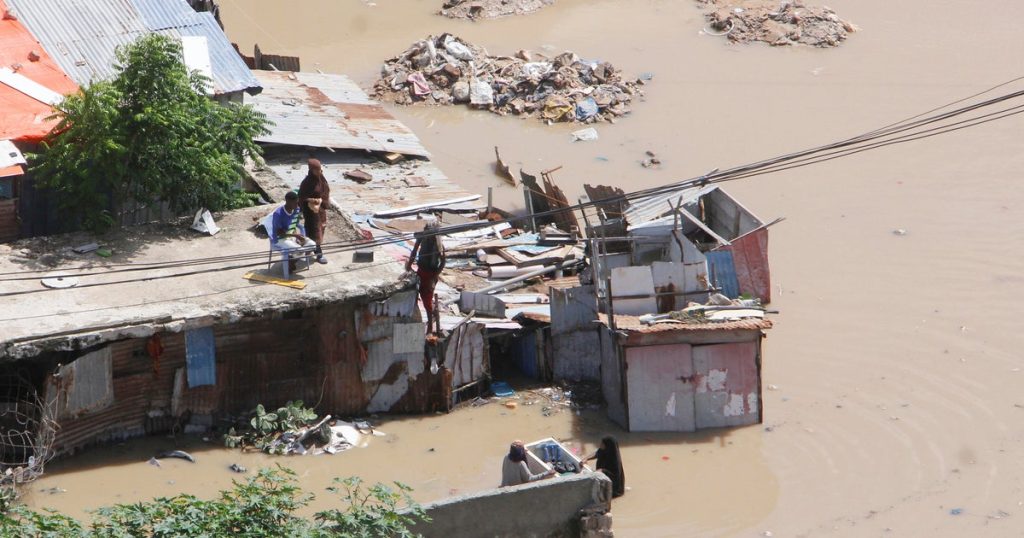Heavy rainfall in Somalia’s capital, Mogadishu, on Friday night has resulted in at least seven fatalities and significant infrastructural damage due to flooding. The combination of an overwhelmed drainage system and a rapidly growing urban populace has exacerbated the situation, leading to widespread evacuations and ongoing rescue operations. As local authorities assess the extent of the damage, the humanitarian crisis continues to unfold amidst fears of rising casualty numbers.
| Article Subheadings |
|---|
| 1) Flooding Crisis in Mogadishu |
| 2) Ongoing Rescue Efforts |
| 3) Infrastructure Damage Assessment |
| 4) Historical Context of Flooding in Somalia |
| 5) Future Implications and Precautions |
Flooding Crisis in Mogadishu
On the night of May 10, 2025, a torrential downpour hit Mogadishu, leading to severe flooding in various neighborhoods. The rains persisted for approximately eight hours, causing water levels to rise to waist height in some areas. Consequently, at least seven individuals lost their lives, and many more have been left stranded as floodwaters surged into homes, overwhelming local drainage systems.
As a direct result of the rainfall, authorities declared a state of emergency. The situation forced many residents to flee to rooftops or higher ground as floodwaters quickly infiltrated lower-lying areas. The continuous rainfall not only raised immediate safety concerns, but it also highlighted the vulnerabilities inherent in urban infrastructure, particularly during extreme weather events.
Ongoing Rescue Efforts
In response to the catastrophic flooding, rescue operations are being led by local authorities, including the regional administration and the Somali Disaster Management Agency. On Saturday, spokesperson for the regional administration, Abdinasir Hirsi Idle, noted, “The death toll could rise because the rains were heavy and lasted for several hours, causing significant destruction.” Ongoing efforts include surveying affected neighborhoods and evacuating those in peril.
Local residents expressed distress as they shared their experiences of the flooding. One resident, Mohamed Hassan, recounted how families spent the night on rooftops, cold and anxious about the situation. “We spent the night on rooftops, shivering from the cold, and I haven’t even had breakfast,” he lamented, reflecting the significant impact of the crisis on the local community.
Infrastructure Damage Assessment
In addition to the tragic loss of life, the flooding has severely disrupted essential services in Mogadishu. Numerous roads have been rendered impassable, and critical infrastructure, including the Aden Abdulle International Airport, faced temporary shutdowns. While flights have since resumed, disruptions to public transportation and commerce have left many struggling to access basic needs.
Authorities are actively undertaking assessments to determine the full extent of the damage. The Somali Disaster Management Agency has yet to finalize its death toll but assured the public that the evaluation process is underway. In a statement from the Ministry of Energy and Water, it was reported that rainfall exceeded 115 mm over about eight hours, prompting warnings of potential flash floods in surrounding areas, posing an ongoing threat to local populations.
Historical Context of Flooding in Somalia
Somalia has long been vulnerable to both extreme droughts and devastating floods. The country has experienced multiple climate shocks that threaten its agricultural and infrastructural stability. Historically, severe weather events have destabilized communities, leading to displacements and challenges in recovery efforts. In recent years, climate change has exacerbated these issues, intensifying the extremes of weather patterns and putting additional pressure on urban centers like Mogadishu, which continue to grow.
The current flooding crisis serves as a stark reminder of these ongoing challenges. With urban areas expanding and climate instability increasing, an urgent need for improved water management systems and disaster preparedness has become evident.
Future Implications and Precautions
As Mogadishu faces the immediate fallout of the flooding crisis, the need for proactive measures becomes increasingly apparent. Local officials have called for the implementation of sustainable urban planning practices and improved drainage systems to mitigate the impacts of future flooding. Furthermore, enhanced flood response protocols must be established to provide quicker relief and support for those affected.
In the wake of this disaster, humanitarian organizations are also gearing up to assist affected residents, although logistical challenges remain. The international community is expected to play a critical role in providing the necessary resources to support recovery efforts as the situation develops.
| No. | Key Points |
|---|---|
| 1 | Heavy rains in Mogadishu led to widespread flooding, causing at least seven fatalities. |
| 2 | Local authorities have initiated rescue operations to evacuate stranded residents. |
| 3 | Significant damage to infrastructure has disrupted public transport and airport operations. |
| 4 | The flooding highlights Somalia’s ongoing vulnerability to climate-related disasters. |
| 5 | Calls for improved urban planning and disaster preparedness are intensifying in the aftermath of the crisis. |
Summary
The recent flooding in Mogadishu underscores the urgent need for robust infrastructure and disaster management systems in Somalia. As residents grapple with the effects of extreme weather, authorities and humanitarian organizations face considerable challenges in providing relief. The aftermath of this crisis serves as a critical reminder of the vulnerabilities posed by climate change and urbanization, emphasizing the need for immediate and sustained action to protect affected communities in the future.
Frequently Asked Questions
Question: What caused the flooding in Mogadishu?
The flooding was primarily caused by heavy rainfall lasting for about eight hours, overwhelming local drainage systems in the city.
Question: How are local authorities responding to the crisis?
Local authorities, including the regional administration and the Somali Disaster Management Agency, are conducting rescue operations and assessments to evaluate the damage and assist affected residents.
Question: What future measures are being discussed to prevent such flooding?
Discussions include improving urban planning, enhancing drainage systems, and establishing more effective disaster response protocols to mitigate the impact of future floods.


